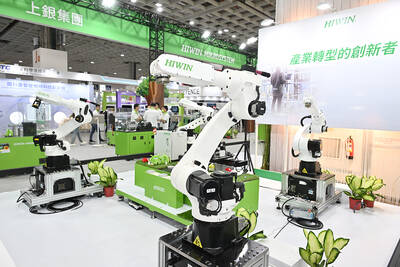The Office of Trade Negotiations said on Thursday that Taiwan would join the US and Japan in resolving a tariff dispute with the EU over certain information technology products.
The office said it would request that a panel be set up during the regular meeting of the WTO dispute settlement body after Aug. 11 at the earliest, Chen Chern-chyi, the office’s negotiator of legal affairs and rules, said at a press conference.
Since 2006, the EU has been imposing tariffs between 6 percent and 14 percent on products, such as liquid-crystal-display (LCD) monitors, set-top-boxes and multi-function printers.
However, under the WTO Information Technology Agreement (ITA), these IT products should enjoy zero-tariff treatment.
“The EU is doing this [imposing 14 percent tariffs] in an attempt to attract Taiwanese LCD firms who wish to avoid high tariffs to set up factories in Eastern Europe and to learn from our experience,” Chen said.
He said the EU has imposed import duties on these IT products as it categorizes them as electrical appliances rather than IT products.
The office aims to put pressure on the EU through the filing of the WTO complaint, in the hope that the EU will compromise, he said.
Indicating that the EU might feel unsettled by the lawsuit, Chen said the EU was said to have considered opening a discussion on whether to exempt more categories of ITA-regulated products after Taiwan registered the complaint.
“The office will be watching out for any possible moves by the EU on the issue,” Chen said. “A lawsuit is just another form of negotiation.”
The office noted that the US and Japan have welcomed Taiwan’s decision to join the lawsuit, as Taiwan is the world’s leading manufacturer of LCD panels.
Taiwan’s annual LCD industry production value has exceeded NT$1 trillion (US$32.79 billion) since 2006 and is likely to generate NT$2 trillion by 2015, official statistics show.
It is estimated that LCD monitors worth around NT$100 billion were exported to the EU last year, and Taiwan’s participation in the lawsuit highlights the significance of the case for the world’s IT industry, Chen said.

AI SERVER DEMAND: ‘Overall industry demand continues to outpace supply and we are expanding capacity to meet it,’ the company’s chief executive officer said Hon Hai Precision Industry Co (鴻海精密) yesterday reported that net profit last quarter rose 27 percent from the same quarter last year on the back of demand for cloud services and high-performance computing products. Net profit surged to NT$44.36 billion (US$1.48 billion) from NT$35.04 billion a year earlier. On a quarterly basis, net profit grew 5 percent from NT$42.1 billion. Earnings per share expanded to NT$3.19 from NT$2.53 a year earlier and NT$3.03 in the first quarter. However, a sharp appreciation of the New Taiwan dollar since early May has weighed on the company’s performance, Hon Hai chief financial officer David Huang (黃德才)

The Taiwan Automation Intelligence and Robot Show, which is to be held from Wednesday to Saturday at the Taipei Nangang Exhibition Center, would showcase the latest in artificial intelligence (AI)-driven robotics and automation technologies, the organizer said yesterday. The event would highlight applications in smart manufacturing, as well as information and communications technology, the Taiwan Automation Intelligence and Robotics Association said. More than 1,000 companies are to display innovations in semiconductors, electromechanics, industrial automation and intelligent manufacturing, it said in a news release. Visitors can explore automated guided vehicles, 3D machine vision systems and AI-powered applications at the show, along

FORECAST: The greater computing power needed for emerging AI applications has driven higher demand for advanced semiconductors worldwide, TSMC said The government-supported Industrial Technology Research Institute (ITRI) has raised its forecast for this year’s growth in the output value of Taiwan’s semiconductor industry to above 22 percent on strong global demand for artificial intelligence (AI) applications. In its latest IEK Current Quarterly Model report, the institute said the local semiconductor industry would have output of NT$6.5 trillion (US$216.6 billion) this year, up 22.2 percent from a year earlier, an upward revision from a 19.1 percent increase estimate made in May. The strong showing of the local semiconductor industry largely reflected the stronger-than-expected performance of the integrated circuit (IC) manufacturing segment,

COLLABORATION: Softbank would supply manufacturing gear to the factory, and a joint venture would make AI data center equipment, Young Liu said Hon Hai Precision Industry Co (鴻海精密) would operate a US factory owned by Softbank Group Corp, setting up what is in the running to be the first manufacturing site in the Japanese company’s US$500 billion Stargate venture with OpenAI and Oracle Corp. Softbank is acquiring Hon Hai’s electric-vehicle plant in Ohio, but the Taiwanese company would continue to run the complex after turning it into an artificial intelligence (AI) server production plant, Hon Hai chairman Young Liu (劉揚偉) said yesterday. Softbank would supply manufacturing gear to the factory, and a joint venture between the two companies would make AI data